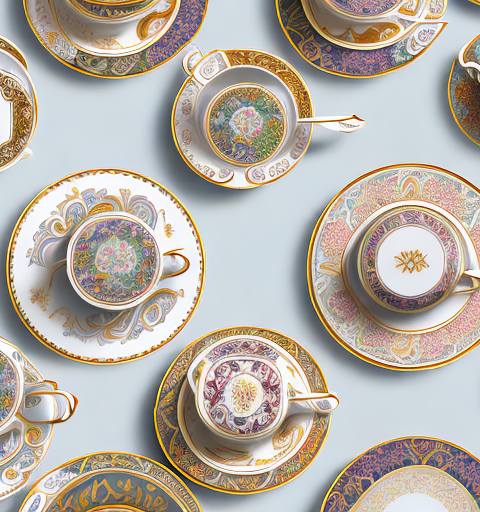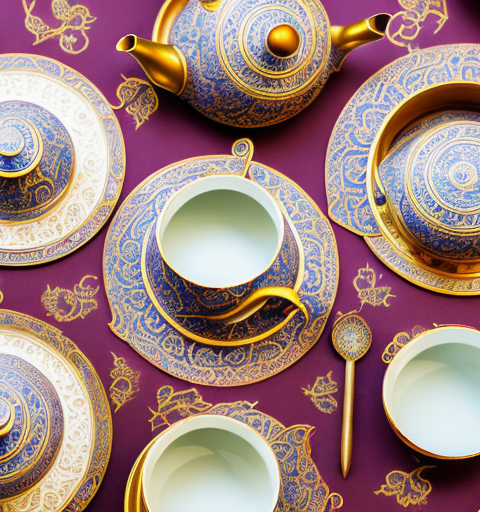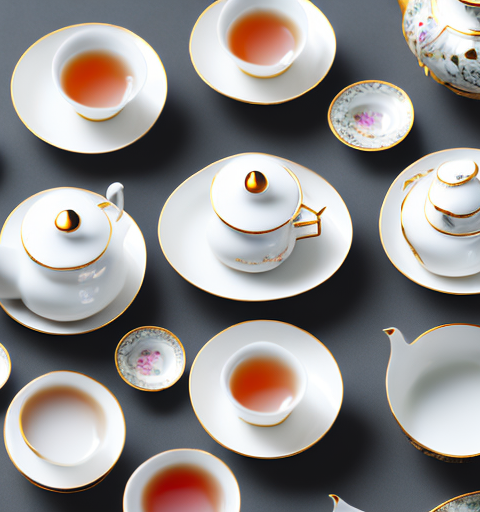Welcome to our comprehensive guide on using ceramic teapots for brewing tea blends with a creamy texture. In this article, we will delve into the importance of tea brewing vessels, explore the versatility of ceramic teapots, and discuss various techniques to achieve that delightful creamy texture in your tea blends. Whether you’re a tea enthusiast looking to enhance your tea-drinking experience or a beginner curious about the art of tea brewing, this article has got you covered.
Understanding the Importance of Tea Brewing Vessels
When it comes to brewing tea, the choice of the right brewing vessel can significantly impact the quality and characteristics of the tea. Ceramic teapots have long been cherished for their ability to retain heat evenly, which offers you a more controlled and consistent brewing experience. The porous nature of ceramic also allows for better heat retention during steeping, enabling the flavors and aromas to fully infuse into the tea.
In addition to its technical attributes, using a ceramic teapot adds a touch of elegance to your tea brewing ritual. The beauty of the teapot enhances the overall tea-drinking experience, making it a feast for both the palate and the eyes.
Another popular choice for tea brewing vessels is glass. Glass teapots allow you to visually appreciate the brewing process, as you can see the tea leaves unfurl and the colors of the infusion change. This transparency also helps in determining the strength of the tea, as you can observe the color intensity. Glass teapots are also non-porous, which means they won’t retain any flavors or aromas from previous brews, ensuring a clean and pure taste every time.
For those seeking a more traditional and authentic tea experience, clay teapots, such as Yixing teapots, are highly regarded. Made from special clay found in the Yixing region of China, these teapots are known for their ability to absorb the flavors and aromas of the tea over time. This seasoning process, known as “tea petrification,” enhances the taste of the tea with each brew. Clay teapots are also prized for their heat retention properties, allowing for a longer and more enjoyable tea-drinking session.
Exploring the Versatility of Ceramic Teapots
Ceramic teapots are incredibly versatile, making them an ideal choice for brewing a wide range of tea blends, including those with a creamy texture. From delicate white teas to robust black teas, ceramic teapots can handle them all. The neutral material of ceramic allows the true flavors and textures of the tea to shine through without imparting any unwanted tastes or odors. This versatility makes ceramic teapots a great investment for any tea enthusiast.
Exploring the Versatility of Ceramic Teapots
Ceramic teapots are incredibly versatile, making them an ideal choice for brewing a wide range of tea blends, including those with a creamy texture. From delicate white teas to robust black teas, ceramic teapots can handle them all. The neutral material of ceramic allows the true flavors and textures of the tea to shine through without imparting any unwanted tastes or odors. This versatility makes ceramic teapots a great investment for any tea enthusiast.
In addition to their versatility in brewing different types of tea, ceramic teapots also offer excellent heat retention. The thick walls of ceramic teapots help to keep the tea hot for a longer period of time, allowing tea drinkers to savor their brew at their own pace. This is especially beneficial for those who enjoy leisurely tea sessions or for serving tea to a group of friends or family members. The heat retention properties of ceramic teapots ensure that each cup of tea remains warm and enjoyable until the last sip.
The Art of Brewing Tea Blends: Achieving a Creamy Texture
Brewing tea blends with a creamy texture requires a delicate balance of factors such as tea selection, infusion techniques, and water quality. To create that luscious creaminess, it is crucial to choose tea blends that naturally have creamy notes. Examples include certain oolong teas, milk oolong, and some black teas like Keemun. These teas possess inherent characteristics that lend themselves well to achieving a creamy texture.
When brewing these tea blends in a ceramic teapot, it’s essential to pay attention to the infusion technique. Optimal results can be achieved by using a slightly higher tea-to-water ratio and extending the steeping time. This allows for a more pronounced extraction of the creamy flavors and textures.
In addition to tea selection and infusion techniques, water quality also plays a significant role in achieving a creamy texture in tea blends. Using filtered or spring water is recommended to avoid any impurities or minerals that may affect the taste and texture of the tea. The purity of the water allows the natural creamy notes of the tea to shine through, enhancing the overall experience.
Choosing the Right Tea Blends for a Creamy Texture
The choice of tea blends is a crucial factor in obtaining that desired creamy texture. While several tea varieties can lend themselves well to creamy notes, it’s essential to select the right tea blends to ensure the best results. Experimenting with different teas such as milk oolong, creamy black teas, or teas with natural creamy flavorings can help you discover the profiles that suit your taste preferences.
When selecting tea blends, it’s also important to consider the quality of the tea. Opt for loose leaf teas that are fresh and have been harvested during the right season. This ensures that the leaves have the optimum chemical composition to impart those creamy flavors and textures.
Another factor to consider when choosing tea blends for a creamy texture is the brewing method. Different brewing techniques can affect the overall creaminess of the tea. For example, using a lower water temperature and longer steeping time can enhance the creamy flavors, while a higher temperature and shorter steeping time may result in a lighter texture.
In addition to the tea blends themselves, the water quality can also impact the creaminess of the tea. Using filtered or spring water can help bring out the natural flavors and textures of the tea, resulting in a smoother and creamier cup. Avoid using tap water, as it may contain impurities that can affect the taste and texture of the tea.
Tips and Tricks for Brewing Tea Blends with a Creamy Texture in a Ceramic Teapot
Now that we’ve covered the basics, let’s dive into some practical tips and tricks to help you achieve that perfect creamy texture in your tea blends when using a ceramic teapot. These techniques will help elevate your tea brewing skills and allow you to enjoy a velvety smooth cup of tea every time.
1. Preheat your ceramic teapot: Before brewing, rinse your teapot with hot water to preheat it. This ensures that the teapot maintains a consistent temperature throughout the steeping process.
2. Use fresh, high-quality tea: Invest in loose leaf teas that are known for their creamy characteristics. The quality of the tea directly affects the creaminess and overall flavor of your brew.
3. Adjust the steeping parameters: Experiment with longer steeping times to allow the flavors and textures to fully develop. However, be cautious not to overbrew, as it can result in bitterness.
4. Consider water quality: The type and quality of water you use can greatly impact the taste of your tea. Opt for filtered water or spring water to ensure the purest flavor.
5. Use a lower water temperature: When brewing tea blends for a creamy texture, it is recommended to use a slightly lower water temperature than usual. This helps to prevent the tea from becoming too bitter and allows the creamy flavors to shine through.
6. Experiment with milk or cream: If you prefer an even creamier texture in your tea, consider adding a splash of milk or cream. This can enhance the richness and smoothness of the brew, creating a luxurious drinking experience.
The Science Behind Achieving a Creamy Texture in Tea
Understanding the science behind achieving a creamy texture in tea can provide valuable insights into the brewing process. When the tea leaves are steeped, certain compounds known as catechins combine with proteins and fats present in the tea to create a milk-like texture. These compounds are more prevalent in teas that naturally exhibit creamy notes, and the right brewing techniques can help bring out these characteristics.
One important factor in achieving a creamy texture in tea is the temperature of the water used for brewing. The ideal temperature for extracting catechins and other compounds that contribute to a creamy texture is around 175°F (80°C). Water that is too hot can cause these compounds to break down, resulting in a less creamy texture. Additionally, the steeping time also plays a role in the texture of the tea. Steeping the tea for too long can lead to a bitter taste and a thinner texture, while steeping for too short a time may not fully extract the creamy compounds. Finding the right balance of temperature and steeping time is key to achieving a perfectly creamy cup of tea.
Enhancing the Creaminess: Adding Milk or Cream to Tea Blends
If you want to further enhance the creaminess of your tea blends, you can consider adding milk or cream to your cup. This is a popular choice for teas such as black teas and milk oolongs, which have the capacity to blend harmoniously with dairy products. The addition of milk or cream can add richness and velvetiness to the tea, creating a delightful indulgence.
When adding milk or cream, it’s important to do so gradually, allowing yourself to adjust the balance according to your taste preferences. Remember, the goal is to complement the tea’s creamy flavor, not overpower it.
One important consideration when adding milk or cream to tea blends is the temperature of the liquid. It is recommended to heat the milk or cream before adding it to the tea, as adding cold dairy products to hot tea can cause the temperature to drop significantly. This can result in a lukewarm cup of tea, which may not be as enjoyable.
Additionally, the type of milk or cream you choose can also impact the overall flavor and creaminess of the tea. Whole milk is often preferred for its higher fat content, which contributes to a richer and creamier taste. However, if you prefer a lighter option, you can opt for low-fat milk or even non-dairy alternatives such as almond milk or oat milk.
Exploring Different Infusion Techniques for Creamy Tea Blends in a Ceramic Teapot
There are various infusion techniques you can experiment with to achieve the desired creamy texture in your tea blends. Here are a few techniques to consider:
Gongfu-style brewing: This Chinese tea brewing method involves multiple short steepings using a higher tea-to-water ratio. Gongfu-style brewing can intensify the creamy flavors and textures of the tea blends, providing a more robust and immersive sensory experience.
Sous Vide Tea Infusion: Incorporating the sous vide technique can result in a creamy and well-rounded cup of tea. This method involves placing the teapot in a temperature-controlled water bath for a more precise and controlled infusion.
Whisking Method: Another technique to explore is the whisking method, commonly used in Japanese tea ceremonies. This method involves vigorously whisking the tea powder, such as matcha, with hot water using a bamboo whisk. The whisking action creates a frothy and creamy texture, enhancing the overall taste and mouthfeel of the tea.
Unlocking the Flavor Potential: Steeping Time and Temperature for Creamy Tea Blends
When it comes to steeping time and temperature, finding the right balance is crucial to unlock the flavor potential of creamy tea blends. Generally, steeping temperatures between 185°F and 200°F (85°C-93°C) work well to extract the creamy flavors. Steeping times can range from 3-5 minutes, but it’s always best to experiment to find your preferred balance of flavors.
The Role of Water Quality in Brewing Creamy Textured Tea Blends
Water quality plays a significant role in brewing tea blends with a creamy texture. The composition of the water can affect the extraction of compounds responsible for delivering those creamy flavors. Hard water, for example, can hinder the extraction process and result in a less creamy cup of tea.
Using filtered or spring water can help ensure the purest flavor when brewing tea blends. If your local water source is not ideal for tea brewing, consider using bottled spring water or invest in a water filtration system specifically designed for improving the taste of water used in tea preparation.
Maintaining and Caring for Your Ceramic Teapot for Optimal Brewing Results
To maximize the lifespan and performance of your ceramic teapot, it’s essential to maintain and care for it properly. Here are some tips to help you keep your teapot in optimal condition:
1. Cleaning: After each use, rinse your teapot with warm water to remove any remaining tea residue. Avoid using soap or abrasive cleaners, as they can affect the flavor of future brews.
2. Removing stains: If your teapot develops stains over time, you can use a mixture of warm water and baking soda or lemon juice to gently scrub away the discoloration.
3. Storing: When not in use, store your teapot in a cool and dry place to prevent any damage or excessive moisture absorption. It’s also advisable to store it without the lid on to allow air circulation.
Experimenting with Flavors: Creating Unique and Delicious Creamy Tea Blend Recipes
To truly indulge your taste buds, consider experimenting with flavors and creating your own unique and delicious creamy tea blend recipes. By blending different teas, herbs, spices, and even adding natural sweeteners, you can create a truly personalized tea experience. Get creative and let your imagination guide you as you explore the vast world of creamy tea blends.
Exploring Alternative Brewing Methods for Creamy Textured Tea Blends in a Ceramic Teapot
While ceramic teapots are a popular choice for brewing creamy textured tea blends, there are alternative brewing methods that you can also explore. Glass teapots, for example, allow you to visually appreciate the infusion process, while clay teapots can impart a subtle earthiness to the tea’s flavor profile. Each brewing method offers a unique experience, and it’s always fascinating to experiment and discover your personal preferences.
Troubleshooting Common Challenges When Brewing Tea Blends with a Creamy Texture
Even with the right knowledge and tools, challenges can arise when brewing tea blends with a creamy texture. Here are some common challenges and their potential solutions:
Bitterness: If your tea blend turns out bitter, try reducing the steeping time or adjusting the water temperature. Additionally, make sure you are using fresh tea leaves of high quality.
Lack of Creaminess: If your tea lacks the desired creamy texture, ensure that you are using tea blends known for their creaminess and following appropriate brewing techniques, such as longer steeping times and slightly higher tea-to-water ratios.
Inconsistent Flavor: Inconsistent flavor could be a result of inconsistent tea leaf quality or incorrect measurement of tea leaves. Make sure to use fresh, high-quality loose leaf tea and measure your tea accurately.
We hope this guide has provided you with valuable insights into using a ceramic teapot for brewing tea blends with a creamy texture. Remember, tea brewing is a personal journey, and experimentation is key. Embrace the art of tea brewing, and enjoy the velvety pleasures of creamy tea blends in the comfort of your home.






